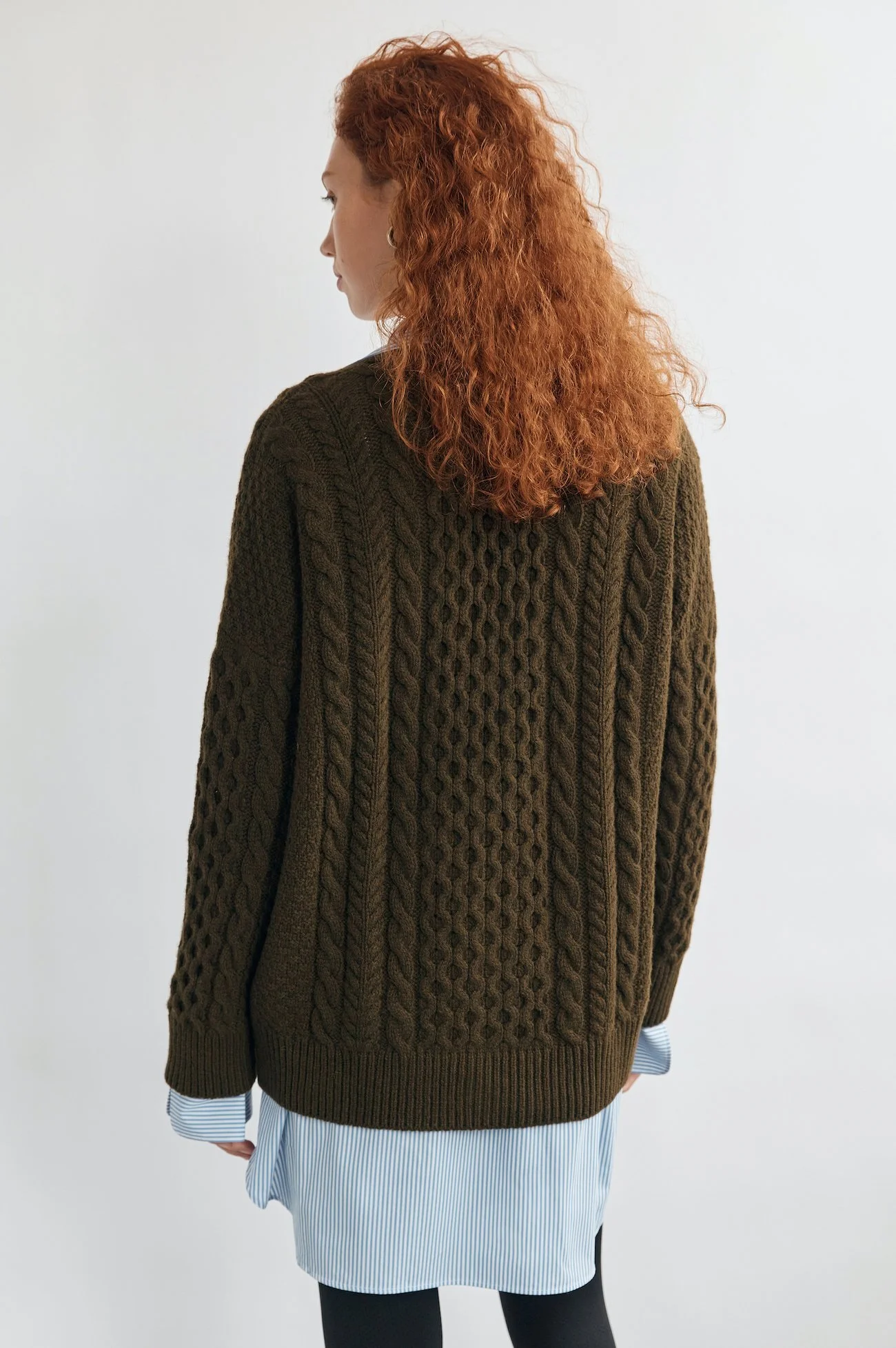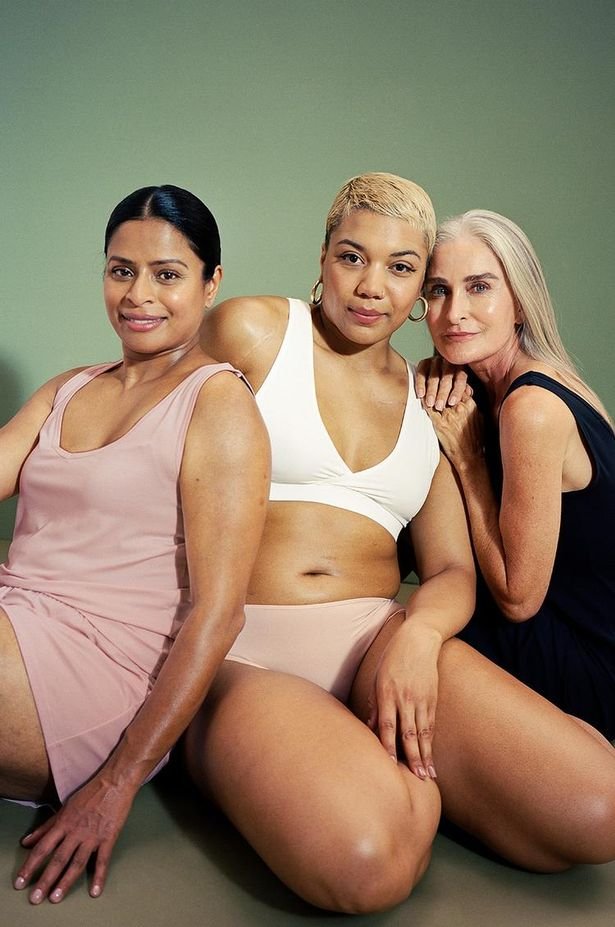For the Love of Aran
image via & Daughter
“We export all our best stuff,” says the Irish mother waving her emigrant son and his wife off to Berlin in the 2019 Kerrygold advert, which I never knew had a title. It’s called The Sod apparently. Acceptance overseas has always been the benchmark by which we Irish rate both our products and our people. From Cashel Blue and Cillian Murphy to Niall Horan and Aran knits, appreciation abroad is often required before it’s bestowed on home shores.
In the case of the Aran jumper, this heritage garment has had more celebrity endorsements than Chanel No. 5. It’s been hailed by American designer Michael Kors as “a lasting design of beautiful craftsmanship and texture” and by French designer Isabel Marant as “iconic”. Actress Sarah Jessica Parker has one in teal, designer Alexa Chung was photographed wearing one in traditional cream, while supermodel Gigi Hadid owns one in unconventional black. What was once described as fishermen’s fashion has consistently made waves among the world’s fashion elite; in 1970, Grace Kelly appeared on the cover of British Vogue wearing one.
The Aran sweater’s most recent supporter, of course, is singer/songwriter Taylor Swift, who chose the traditional cable knit sweater for a publicity shot for her eighth studio album, “Folklore” released last July. It sparked a slew of editorials, and according to The Times prompted a slew of sales of Aran jumpers in both the United States and Ireland. Yet despite all the celebrity sightings and catwalk reincarnations, the Aran jumper has never really taken hold as a certifiable fashion essential here in Ireland, or at least not in Dublin where I live.
Fashion editor of The Irish Times Deirdre McQuillan agrees and believes this is because the indigenous piece has yet to be reimagined to any great degree in a manner that suits city rather than country life. “The traditional Aran would need to be reworked in new ways, and not just in wool but in cotton, silk, cashmere and merino, to be attractive to us,” she explains. The weight of a traditional Aran jumper, which is made from a yarn called báinín spun from sheeps’ wool, is a factor, McQuillan adds, “as well as not wanting to look like one of The Clancy Brothers!”
The Irish folk group, which emerged on the Greenwich Village music scene in New York in the 1960s, wore Aran sweaters for their first appearance on the Ed Sullivan television show in 1963. Looking back, it feels horribly twee and clichéd, but the fashion for Aran was at its height in the sixties, with the traditionally Gaelic handknit style appearing in Paris couture collections. At this time, it projected an image not of backwardness or lack of sophistication but of modernity and relevance.
From Connemara to couture to American chat shows; it’s not surprising then that in 2017, an original 1940s Aran sweater was chosen for inclusion in an exhibition on fashion classics at the Museum of Modern Art in New York. It was one of just 111 pieces, sitting alongside a pair of 1940s Levi’s 501s and a 1950s biker jacket, among others.
Irish designer Simone Rocha is one tastemaker looking to preserve by reinvigorating the indigenous knit with a present-day fashion currency. Speaking about her AW20 collection, she told Vogue.com, “It is interesting to pay respect to traditions, but to look at them in a way for today, and how they can be translated and feel present.” The results were deconstructed cardigans and oversized scarves reminiscent of fishermen’s lengthy knotted ropes. Michael Kors, meanwhile, captured the zeitgeist perfectly in his AW20 collection, offering chunky double-layered Aran knits in shades of shortbread and slate, explaining before his show that they offered, “polish and glamour but cosiness at the same time”.
As we navigate our third lockdown and absorb the reality that life will probably never be exactly as it was before, perhaps this is the perfect time for Irish women to embrace Aran jumpers and give them the same kind of fashion credibility at home as they have abroad.
McQuillan is right in her assertion that the traditional cable knits have always been “more beachside than stateside”, but how many of us now spend at least part of everyday walking a beach, coastline, forest or city park? Covid has transformed city living. Where once we drove to every destination, sat in centrally-heated offices, or browsed stuffy, overcrowded department stores, we’re now at home seven days a week, trying not to run up an astronomical heating bill, and when we’re not indoors, we’re travelling on foot within our 5km radius.
Polished cosiness is exactly what we need at this moment, and while Aran sweaters are necessarily costly because of the time and craftsmanship invested in them, McQuillan tells me there are a few exceptions, which are affordable and come in lighter wools, making them perfectly wearable in springtime too.
image via Stable of Ireland
Stable of Ireland, for instance, has a Donegal Aran jumper available, which is made from merino wool, for €195. It’s not handknitted (it offers these too but at €495), with the traditional blackberry stitch that characterises handmade Arans – it cannot be achieved with a knitting machine – replaced by an equally textured basketweave stitch. It also features a diamond stitch, which is made to look like fishing nets, and a cable stitch, which is said to reflect the intertwining strands of life.
Rich mythology is woven into every Aran knit, and in turbulent times, this brings with it a kind of intangible, almost existential, comfort that I think we could all benefit from.
The word authenticity is spoken of so often with regard to fashion and, indeed, our own wardrobes, and this indigenous item encapsulates everything the industry is striving to achieve in this new decade – quality, context, longevity.
Original Aran Company | Cardigan - Navy with Olive Fleck, €86, Scoutdublin.com
The Aran I’ll be adding to my basket shortly is a navy with olive fleck cardigan in merino wool made by the Original Aran Company in Donegal and stocked by Scout, one of my favourite independent boutiques based in Temple Bar. I buy cardigans the way other women buy shoes. At €86, it won’t take long to justify its cost-per-wear. I think the way to wear an Aran knit in the city is in a non-traditional fashion. If lockdown ever ends, I’ll be pairing mine with a navy satin sheen dress I bought recently from Arket. The juxtaposition of a traditional textured cardi with a fluid, subtly shimmery dress will feel fresh and interesting. Right now, on my daily walks, I’ll wear it with luxe joggers or cargo pants.
McQuillan tells me it drives her mad when “European designers take hold of it [the Aran knit]...and give it modern voltage and relevance.” She’s right. It’s up to each of us, as well as Irish designers like Rocha and JW Anderson, to promote and value our indigenous designs, but not by visiting them in museums or reading and writing about them; by wearing them.
Marie Kelly, January 2021
what do you think, dear reader?
tell us in the comments down below.
join the conversation
share and comment below, we’d love to hear your thoughts…













